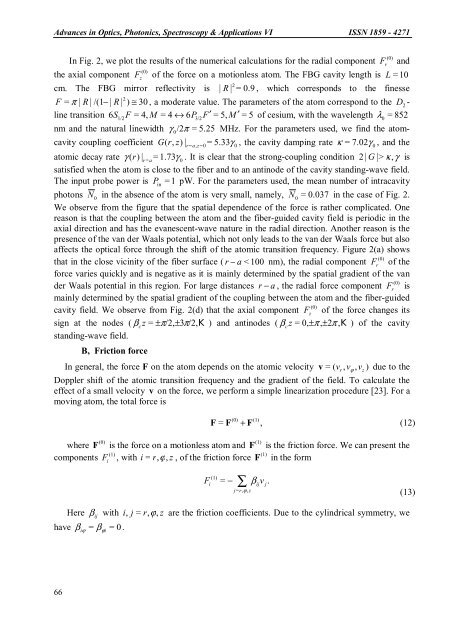Nhng tin b trong Quang hc, Quang ph và ng dng VI ISSN 1859 - 4271
Nhng tin b trong Quang hc, Quang ph và ng dng VI ISSN 1859 - 4271
Nhng tin b trong Quang hc, Quang ph và ng dng VI ISSN 1859 - 4271
You also want an ePaper? Increase the reach of your titles
YUMPU automatically turns print PDFs into web optimized ePapers that Google loves.
Advances in Optics, Photonics, Spectroscopy & Applications <strong>VI</strong> <strong>ISSN</strong> <strong>1859</strong> - <strong>4271</strong>(0)In Fig. 2, we plot the results of the numerical calculations for the radial component Frand(0)the axial component Fzof the force on a motionless atom. The FBG cavity le<strong>ng</strong>th is L = 102cm. The FBG mirror reflectivity is | R | = 0.9 , which corresponds to the finesse2F = π | R | /(1− | R | ) ≅ 30 , a moderate value. The parameters of the atom correspond to the D2-line transition 6S 1/2F= 4, M = 4 ↔ 6P3/2F′= 5, M ′ = 5 of cesium, with the wavele<strong>ng</strong>th λ0= 852nm and the natural linewidth γ0/2π= 5.25 MHz. For the parameters used, we find the atomcavitycoupli<strong>ng</strong> coefficient G ( r,z)|r= a,z=0= 5.33γ0, the cavity dampi<strong>ng</strong> rate κ = 7.02γ0, and theatomic decay rate γ ( r ) |r = a= 1.73γ0. It is clear that the s<stro<strong>ng</strong>>tro<strong>ng</strong></stro<strong>ng</strong>>-coupli<strong>ng</strong> condition 2 | G |> κ, γ issatisfied when the atom is close to the fiber and to an an<s<stro<strong>ng</strong>>tro<strong>ng</strong></stro<strong>ng</strong>>>tin</s<stro<strong>ng</strong>>tro<strong>ng</strong></stro<strong>ng</strong>>>ode of the cavity standi<strong>ng</strong>-wave field.The input probe power is Pin= 1 pW. For the parameters used, the mean number of intracavity<stro<strong>ng</strong>>ph</stro<strong>ng</strong>>otons N0in the absence of the atom is very small, namely, N0= 0.037 in the case of Fig. 2.We observe from the figure that the spatial dependence of the force is rather complicated. Onereason is that the coupli<strong>ng</strong> between the atom and the fiber-guided cavity field is periodic in theaxial direction and has the evanescent-wave nature in the radial direction. Another reason is thepresence of the van der Waals potential, which not only leads to the van der Waals force but alsoaffects the optical force through the shift of the atomic transition frequency. Figure 2(a) shows(0)that in the close vicinity of the fiber surface ( r − a < 100 nm), the radial component Frof theforce varies quickly and is negative as it is mainly determined by the spatial gradient of the van(0)der Waals potential in this region. For large distances r − a , the radial force component Frismainly determined by the spatial gradient of the coupli<strong>ng</strong> between the atom and the fiber-guided(0)cavity field. We observe from Fig. 2(d) that the axial component Fzof the force cha<strong>ng</strong>es itssign at the nodes ( βcz = ± π/2,± 3π/2,K ) and an<s<stro<strong>ng</strong>>tro<strong>ng</strong></stro<strong>ng</strong>>>tin</s<stro<strong>ng</strong>>tro<strong>ng</strong></stro<strong>ng</strong>>>odes ( βcz = 0, ± π , ± 2π, K) of the cavitystandi<strong>ng</strong>-wave field.B, Friction forceIn general, the force F on the atom depends on the atomic velocity v = ( vr, vϕ, vz) due to theDoppler shift of the atomic transition frequency and the gradient of the field. To calculate theeffect of a small velocity v on the force, we perform a simple linearization procedure [23]. For amovi<strong>ng</strong> atom, the total force is(0) (1)F = F + F ,(12)(0)(1)where F is the force on a motionless atom and F is the friction force. We can present the(1)components F , with i = r,ϕ , z , of the friction force F in the form(1)iF(1)i= −∑j=r,ϕ,zβ vijj.(13)Here βijwith i , j = r,ϕ , z are the friction coefficients. Due to the cylindrical symmetry, wehave β β = 0.iϕ= ϕi66















